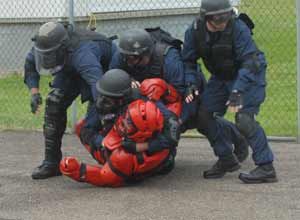| Editor’s note: This article is part of a Corrections1 Special Report on the 2009 Mock Prison Riot in Moundsville, W.V. You can check out the whole report (including exclusive articles and video content) by clicking here. |
By Luke Whyte, Corrections1 editor
.jpg) |
Jeff Richards (whose name has been changed for personal security reasons) wanted participants to take one message from his workshop on British technique for cell entry and extraction.
“This is just a way, it is not the way,” he said. In other words, don’t worry about finding the best method for cell extraction, worry about finding new methods.
This is not to say the British technique is not effective. On the contrary, it has been popular in the UK for more than twenty years. By applying a two-shield system, the British method allows officers to minimize use of force and reduce potential injuries on both sides of the bars. Reduced injuries can lower facility costs and lead to better public perceptions. Further, the method is more controlled than the dynamic ‘pile-on’ and single-shield methods more commonly used in the U.S., Richards said. This gives officers more time to evaluate their circumstances and their potential risks.
But the main thing, he said, is to realize that no matter which method you prefer, the only “best” method for cell extraction is mastering several methods. This allows your team to harness the power of surprise and to constantly stay two steps ahead of the inmates.
Moundsville Penitentiary
|
Mock Prison Riot, May, 2009. “Failure is not an option.” (Pat Weyand photo) |
Richards’ workshop took place in cell block L of the decommissioned Moundsville Penitentiary during the Mock Prison Riot in Moundsville, West Virginia, Monday, May 4, 2009.
Since it closed in 1995, Moundsville has been host to the annual Mock Prison Riot 13 times. The facility has this eerie abandoned feel; perfect for a week of non-stop pepperball smacking and flashbang cracking.
For Richards’ workshop, volunteers were dressed head to toe in RedMan training gear and placed inside cells. Officers were then able to practice Richards’ extraction techniques at near-full intensity in a real cell with a real combatant.
“There’s simply nothing like it,” Ray Merlin of RedMan training gear told me, as we watched a panicked participant scream “I can’t see” from behind a fogged gas mask.
Steps of the British cell-extraction method
“The key thing is to reduce injuries on both sides,” Richards said.
Ideally, you will need four teams of three officers and a total of eight shields that are tall enough to fully block the cell door. In this workshop, British-style Armadillo riot shields were used.
1) The first team should arrange themselves so that two officers, each holding a shield, are standing shoulder to shoulder, with a control officer binding in behind them.
2) When ready, the first team should methodically enter the cell and block the door with the shields. Given the strength of the three man unit, “nobody can really come through,” Richards said.
3) If the inmate continues to resist, the first team should simultaneously penetrate the cell, leading with the shields as the second team forms takes their place blocking the door.
4) The first team’s goal is to secure the prisoner against a corner with the shields. If they start to tire, they can rotate out with the next team.
5) After the prisoner is secured in the corner, the first team (or whichever team happens to be controlling the inmate at the time) calls for support. Phase two begins. Everything slows down.
6) Using the shields, the first team forces the inmate to the ground in a controlled manner. A member of one of the supporting teams pulls the inmate’s feet out from underneath them to aid in this process.
7) The inmate is pinned against the ground by the first team as the supporting team secures their head and extremities.
8) Now that the inmate is immobilized, the officers are clear to search, rotate and remove them from the cell.
Keep ‘em guessing
Ultimately, Richards said, this method of cell extraction should be no more than part of a larger repertoire including single-shield methods, pile-on techniques, impact munitions, gas systems, and Taser tactics. Officers can then tailor individual approaches for their different teams, cells, and prisoners.
“If it is something new, then it is something they haven’t seen before,” Richards said. “If you can have a variety of tactics and methods then it keeps the guys inside unprepared and on the defensive.”
It is a lesson, he said, that is applicable far beyond the realm of cell extraction.
Click below to see video footage from the Cell Entry and Extraction workshop:












